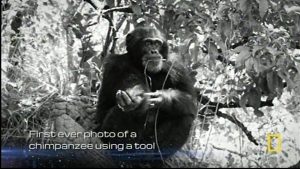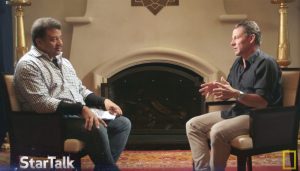Last night on Star Talk, seen Sundays on the National Geographic channel, host Neil deGrasse Tyson had a very interesting and important interview with Jane Goodall, the noted anthropologist and one of the most influential scientists of the last fifty years. Doctor Goodall is of course best known for her intimate studies of Chimpanzee behaviour, studies that have taught us as much about ourselves as our closest relatives.
Neil began the interview by asking Dame Jane, she has been knighted by Queen Elizabeth, how she first got interested in science. Goodall’s answer was rather typical of many scientists. From her earliest days she remembers liking animals and when she was four she and her family visited a relative’s farm where she was given the job of collecting eggs.
After asking the adults where the hole was that the eggs came from, and being given an unsatisfactory answer, Jane proceeded to follow a hen into the henhouse and watched her for four hours. She was gone for so long that her family thought she was lost, the police were even called. Still, she found out where the eggs came from. The image below shows Neil with Jane Goodall.

Every time I’ve seen Jane Goodall interviewed she never fails to mention her mentor the paleoanthropologist Louis Leakey, the man whose discoveries at Olduvai Gorge in what is now the nation of Tanzania gave us the first evidence for the earliest tool using hominids.
In the early 1960s Leakey had learned much about the physiology and tool making abilities of those hominids but “behaviour doesn’t fossilize” and he realized that the best way to understand the behaviour of our ancestors would be to study our closest relatives the Chimpanzees.
Leakey reasoned that any common behaviour shared between ourselves and chimps would probably also be shared with our ancestors. The person he choose for the job was Jane Goodall, who didn’t even have a bachelor’s degree at the time, but she liked animals.
Goodall spent the next five years at Gombe Stream National Park in Tanzania revolutionizing the field of animal research by almost becoming a member of a group of Chimpanzees. Her biggest discovery in those years was the tool making ability of chimps, behaviour that at that times was believed only humans possessed. The image below shows the first photograph of a Chimpanzee using a tool it had made for catching termites from a mound.

Goodall then returned the UK to get her doctorate, her thesis was ‘The Behaviour of Free Living Chimpanzees’. After receiving her degree Goodall returned to Gombe and spent over thirty years studying the Chimpanzees there. She made many more discoveries, such as the fact that chimpanzees hunt; by cooperating they’re actually successful more often than lions are.
Goodall also saw the dark side of chimp behaviour, murder, rape and even war between different groups. Jane Goodall certainly fulfilled Louis Leakey’s desire to learn about the behaviours we share with the chimpanzees.
As always Neil deGrasse Tyson was joined by a couple of guests in the studio at the Hayden planetarium. One was the comic Chuck Nice, a frequent guest who always succeeds in bringing a few laughs to the discussion. The other guest was Anthropologist Jill Pruetz who had clearly been inspired by Jane Goodall in her early life. Doctor Pruetz, who is studying Chimpanzees in Senegal, discussed one aspect of chimp behaviour that even Doctor Goodall missed; Culture!
You see Doctor Goodall spent her career studying a single chimpanzee group in a small area. It wasn’t until other researchers like Doctor Pruetz studied chimps in other parts of Africa that Chimpanzee culture became evident. The evidence of different types of tool use, different styles of nest building and other behaviours, even differences in vocal calls (Language!!!) Show that chimps in different regions have differences that can only be described as cultural. Yet another way that chimpanzees resemble us.
Jane Goodall’s legacy lays in illustrating humanity’s true place in the World, in showing us how we are not as different as we’d like to think we are. The show Star Talk continues to be a place where scientists like Jane Goodall, and their discoveries can be discussed.


